DATE: Sunday, November 11, 2018 TIME: 6:00 p.m.
PLACE: Orvis Auditorium, University of Hawaii at Manoa
Tickets Online: https:ewcarts.eventbrite.com

DATE: Sunday, November 11, 2018 TIME: 6:00 p.m.
PLACE: Orvis Auditorium, University of Hawaii at Manoa
Tickets Online: https:ewcarts.eventbrite.com
As in the past, Okinawa’s distinctive and vibrant artistic tradition continues to thrive.
When I first saw Harry Masuda’s shirt I did not give it much attention thinking it was just another Hawaiian aloha shirt, but when I took a closer look I realized that it was quite different in style and design. His girl friend, Shiori Yamauchi, also studying at the East-West Center, had just bought the shirt at a museum in Okinawa. It was only after asking more questions that I learned about Bokunen Naka and about Okinawa’s thriving contemporary artistic tradition.
Bokunen Naka was born on the island of Izena (Iheya) in 1953 – also the birthplace of King Sho En (1415). As a child he always carried a sketchbook with him and made sketches of Okinawa’s creatures and landscape. At the time he thought he would grow up to be a carpenter or fisherman. One of his teachers recognized his talent and recommended he attend an art-based high school on the island of Okinawa. Bokunen Naka gained recognition from his wood block prints.
He describes his wood block print:
Once the woodblock is finished, I spread black ink on the surface of the wood, and then press it against the paper. The black and white print is a mirror image of the carving in the wood. I then turn the paper over and paint in the colors on the back of the paper. This reverse coloring technique gives the process its name: uratesaishoku.
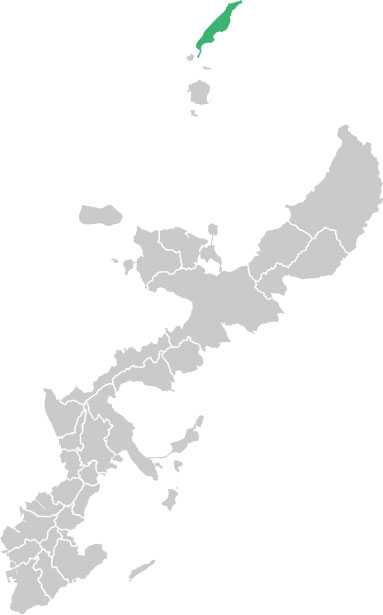
Iheya/Izena Island – birthplace of Bokunen Naka (1953) and King Sho En (1415) source
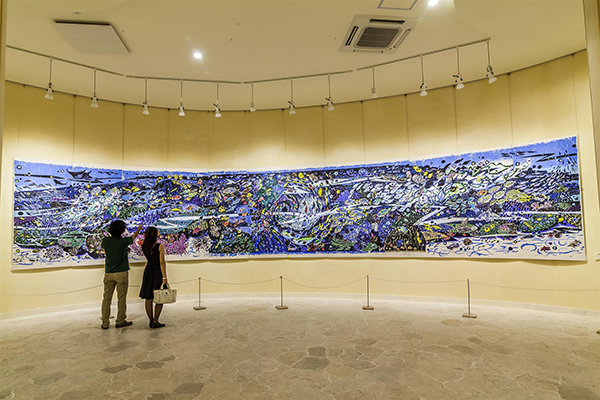
“Daishoenkan” depicting Bokunen Naka’s impression of the world beneath the sea source
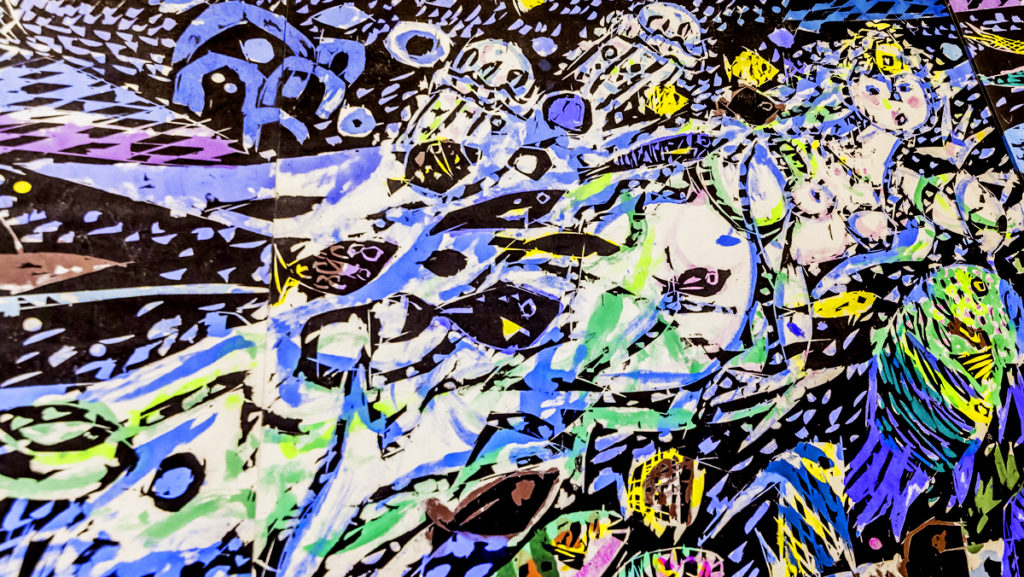
Bokunen Naka block print Source
Recommended Readings
Woodblock Artist Naka Bokunen – 10 years on
Iheya Island/Izena Island – Okinawa Island Guide
In August 2018, a group of middle school and high school students from Miyakojima Island spent a few days in Hawaii to improve their English and learn about Hawaii and American culture.
East-West Center student Yuicihi Harry Masuda and I drove over to the Hawaii Tokai International College out in Kapolei to greet the students and give them a box of ono Leonard’s malasadas.
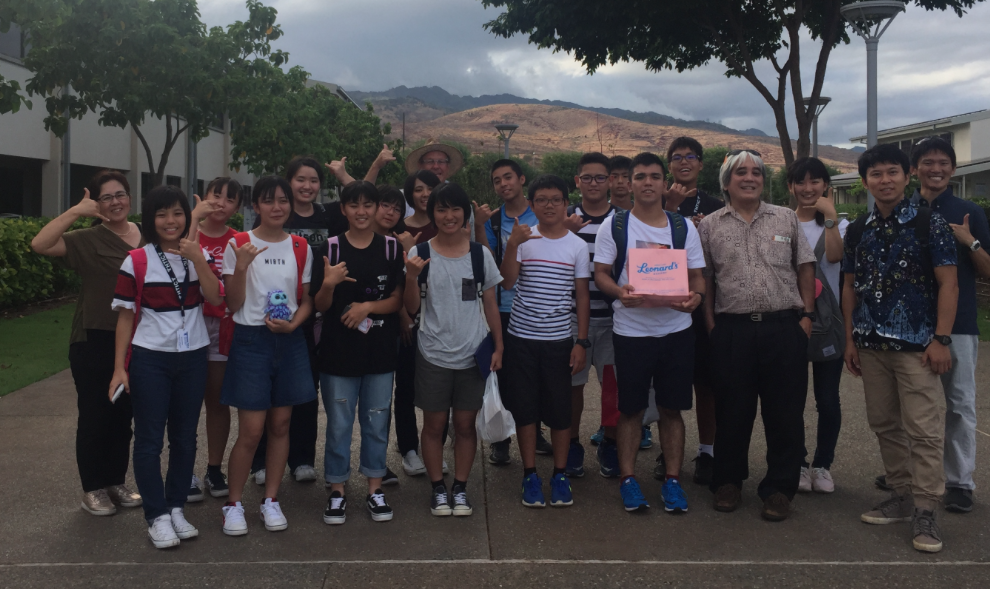
Robert Arakaki and Yuichi Harry Masuda with Miyakojima students. We gave them a box of ono Leonard’s malasadas.
The Ryukyu Kingdom (present day Okinawa prefecture) comprised many islands and multiple languages. The Miyakoan language also Sumafutsu is a language distinct from Nihongo (the language of mainland Japan) and Uchinaaguchi (the language of Okinawa island). Where the people of Okinawa island say “nifedebiru” for “thank you,” the people of Miyakojima say “tandigatandi.” Since coming under Japanese administration, the indigenous language of Miyakojima has been slowly dying out. Today most people in Miyakojima below the age of 60 do not speak Sumafutsu.
Originally from mainland Japan, Harry Masuda moved to Okinawa and learned about Okinawa’s distinctive culture and history. When he attempted to speak to the Miyakojima students in their mother tongue, they waved their hands in embarrassment saying that they spoke Japanese. This cultural and linguistic assimilation presents a serious challenge to the future of Uchinanchu identity in the Uchinanchu/Shimanchu homeland as well among the worldwide Uchinanchu diaspora.
Note: “Uchinanchu” means “people of Uchina or Okinawa Island.” “Shimanchu” means “island people” implying those who belong to the Ryukyus but not necessarily Okinawa Island.
See “Okinawa’s Endangered Languages” also published on the WUB Hawaii website.
Takeshi Onaga, the governor of Okinawa, passed away on 8 August 2018 from complications of pancreatic cancer.
He was born in 1950 in Naha into a political family. His father, Josei, was mayor of Naha at the time of his birth. Although his mother discouraged him from following in his father’s footsteps, Onaga decided, while in elementary school, that he wanted to become a politician. When he studied at Hosei University in Tokyo, Onaga needed a passport from American-occupied Okinawa to enter mainland Japan.
Onaga was a rare conservative politician who stood up to the leaders of Japan’s ruling Liberal Democratic Party. In 2014, he ran for the governorship on a platform that opposed the relocation of the Futenma Air Base to Henoko in northern Okinawa and called for the ending of American occupation of Okinawa. He won the governorship and in October 2015 Onaga revoked the land reclamation permit needed for construction in Henoko.
On 11 August 2018, 70,000 people attended a rally in Okinawa in honor of Governor Onaga’s memory and his struggle against the relocation of Futenma Air Station to Henoko in northern Okinawa.
Onaga enjoyed close ties with Hawaii and was a strong supporter of WUB Network. In a statement read at WUB Network’s 21st Conference, Governor Onaga expressed that “WUB’s engagement in business throughout the world holds immense significance in Okinawa.” (source) Governor Onaga was named Honorary Chair of the 20th WUB Network Conference held during the 2016 Taikai.
During the 2016 Taikai, Governor Onaga joined Hawaii’s Governor David Ige and WUB Network President Steve Kishaba Sombrero.
References
Motoko Rich. 2018. “Okinawa governor criticized U.S. military base presence.” Honolulu Star-Advertiser/ New York Times
Shannon Tiezzi. 2015. “It’s Official: Okinawa Governor Withdraws Permission for US Base Construction.” The Diplomat.
Wu Li Jun. “Celebrating 20 years of bonds built through business, the WUB vow to “Work the Net Together” at conference in Hawaii.” Ryukyu Shimpo, 3 September 2017.
Ryukyukoku Matsuri Daiko Hawaii (RMD Hawaii) is delighted to present “The Dawn of Ryukyu” on July 24, 2018 at the Hawaii Okinawa Center. This special event can be enjoyed by all ages, and will feature a medley of Okinawan performing arts to tell the story of ancient Okinawa. General Admission tickets are just $35 and $40 at the door. Please contact Brianne Yamada at yamadabri@gmail.com or (808)285-3905 for ticket purchases. Thank you!
❖ Reserved VIP tickets each for $100, includes and early entrance at 6 pm, reserved seating, and an okashi gift box. With the purchase of each pair of tickets, a parking pass will be provided.
❖ Preferred Seating at $50, which includes early entrance at 6 pm, and preferred seating (first come, first serve).
❖ General Admission at $35, or $40 at the door, providing seats in the open seating area (first come, first serve).
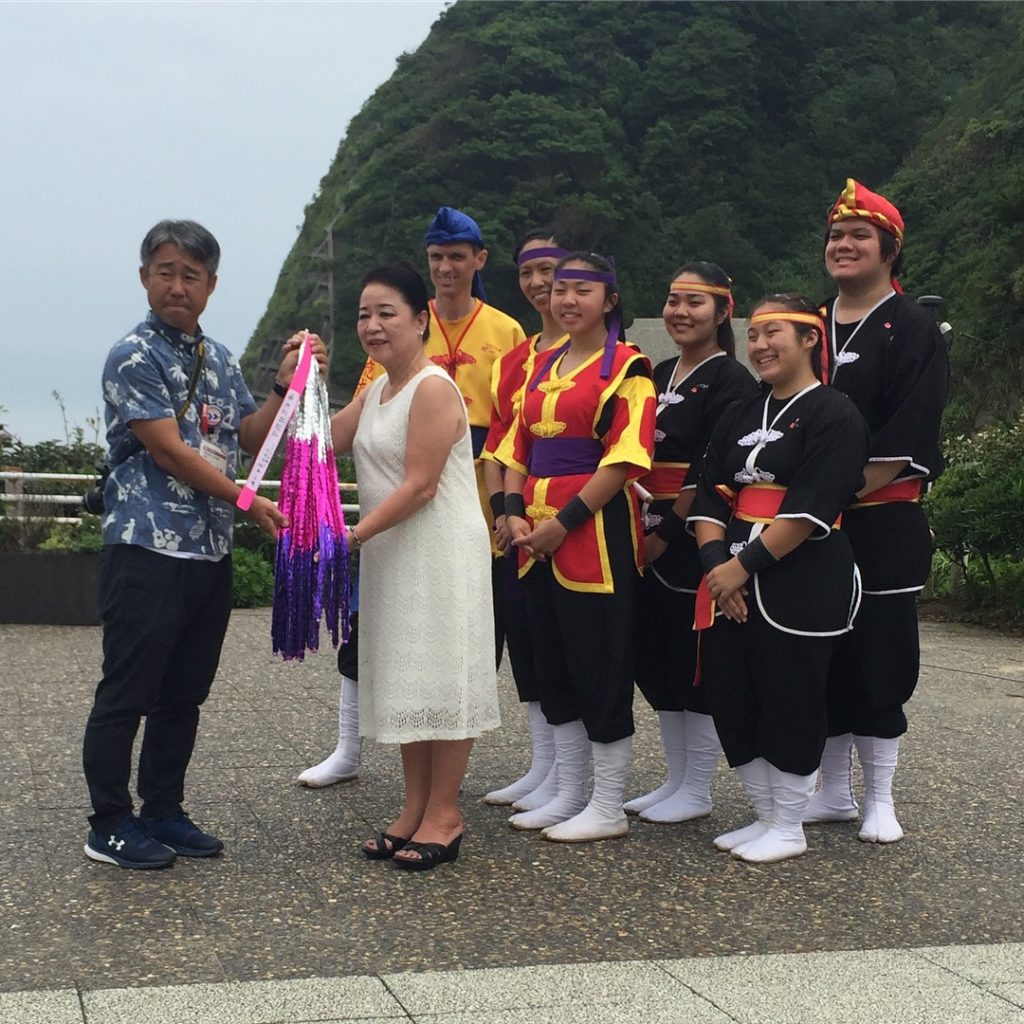
Akemi Martin with Ryukyukoku Matsuri Daiko source
WUB Hawaii Vice President, Akemi Martin, founded Ryukyukoku Matsuri Daiko’s Hawaii chapter that includes branches on Oahu, Kauai, Maui and the Hawaii Island. Ryukyukoku Matsuri Daiko originated in Okinawa in 1982. It combines traditional Eisa and Karate forms with contemporary influences and music creating a new and unique taiko style.
Time Sunday 1:00 to 4:00
Location Shidler College, University of Hawaii at Manoa – Room A-101
Reviews
Japan Times by Mark Schilling (brief)
EMRO (Educational Media Reviews Online) – by Joseph Baumstarck (detailed)
On 11 March 1879, King Sho Tai was forced by Japan to vacate his throne, leave Shuri Castle, and relocate to Tokyo.
In January 1879, 160 military police and 400 soldiers from Japan seized control of the Ryukyus. In February 1879, China through formal diplomatic communications urged Japan not to unilaterally annex the Ryukyus. On 18 March 1879, Nabeshima Naoyoshi was installed as the first governor of Okinawa Prefecture. This annexation is known as the Ryûkyû shobun (琉球処分).
Matsuda Michiyuki returned to Ryûkyû in January 1879, and again in March, this time bringing with him a considerable entourage including 160 military police, and 400 soldiers from the Kumamoto Garrison. In February, Beijing sent diplomatic communications formally urging Tokyo to not unilaterally annex the Ryukyus. On March 27, Matsuda presented to Prince Nakijin the formal document declaring the abolition of the Ryûkyû Kingdom and the annexation of its lands as Okinawa Prefecture. King Shô Tai was given until March 31 to vacate the castle and leave for Tokyo; there, he would officially submit to the Emperor, be stripped of his title as “King” (or, by this time, han’ô), and be absorbed into the Japanese peerage as a Marquis (kôshaku). The king did so on March 30, and Japanese authorities immediately took over Shuri castle, installing a military garrison there. Source
The Kingdom of Hawaii would share a similar tragedy in 1893 when Her Majesty Queen Lili`uokalani was forced by Americans to vacate her throne. The Hawaiian islands were annexed by US Congress in 1898 against the express wishes of the overwhelming majority of the indigenous population and without a referendum of any kind. Today both islands bear the burdens of military occupation and mainland colonialism.

Ua Mau ke Ea o ka ʻĀina i ka Pono – The island’s sovereignty is perpetuated by rightness.
The recent discovery of ancient coins at Katsuren Castle in Uruma, Okinawa shows that the Ryukyu Kingdom was a vital part of international trade between Asia and the West.
The coins date as early as the third century during the time of Constantine I, the first Roman Emperor to convert to Christianity, to the Ottoman Empire of the seventeenth century.
Katsuren Castle was built by the Aji (Lord) of Katsuren, Amawari (d. 1458). Through maritime trade Amawari acquired considerable wealth and power. He married Momotofumi Agari, the daughter of King Sho Taikyu (reigned 1454-1460), further solidifying his power. In 1458, the King, discovering Amawari’s treachery, led an attack on Katsuren castle and killed him. Today the ruins of Katsuren Castle is recognized as a UNESCO World Heritage site.
In the past the Ryukyu Kingdom was an important entrepôt (center of trade) much like present day Singapore. An awareness of our Uchinanchu history helps us to escape the present day nationalist narrative which depict Okinawa as one of the poorer prefectures lying on the edge of Japan and instead envision an Okinawa thriving under conditions of greater political and economic independence.
Reference
“Ancient Roman coins unearthed from castle ruins in Okinawa.” Japan Times 26 September 2016.
Agenda: Prof. Robert Huey will talk about Prof. Mamoru Akamine’s forthcoming book Ryukyu Kingdom, Cornerstone of East Asia. This book surveys the history of the Ryukyus from the time of the three kingdoms up to the Japanese annexation.
Date: 6:00 pm October 9, 2014 Thursday
Location: Maple Garden Restaurant 909 Isenberg Street